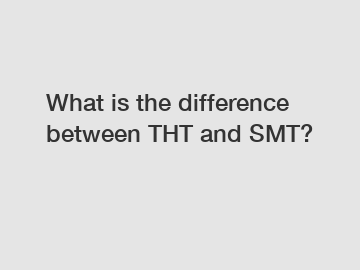Jan. 27, 2024
Machinery
Link to Hayawin
In the realm of electronic manufacturing, two prominent methods have revolutionized the industry—Through-Hole Technology (THT) and Surface Mount Technology (SMT). Both techniques have their unique perks and are employed for different purposes. In this blog, we will explore the significant differences between THT and SMT, shedding light on their respective advantages, applications, and impact on electronic devices. By the end, you will gain a comprehensive understanding of how these technologies have shaped modern electronics.
1. What is Through-Hole Technology (THT)?

Through-Hole Technology, often referred to as "Through-Lead" or "Thru-Hole," was the primary method used for assembling electronic components before the advent of SMT. In THT, the leads of the components are inserted through pre-drilled holes in the printed circuit board (PCB). The leads are then soldered to the opposite side of the board, forming reliable connections.
THT became popular for its robust construction, mechanical strength, and resilience against environmental factors such as vibrations and shocks. It is commonly used for large components, connectors, and devices requiring high power or capable of handling high current.
2. Exploring Surface Mount Technology (SMT):
Surface Mount Technology revolutionized electronic manufacturing by introducing a more compact and efficient alternative to THT. In SMT, tiny components, such as resistors, capacitors, and integrated circuits, are mounted directly onto the surface of the PCB. These components, often referred to as surface mount devices (SMDs), have no leads or terminations.
With SMT, electronic manufacturers can maximize board space utilization, reduce weight, and enhance the overall performance of electronic devices. Additionally, SMT enables automated assembly processes, significantly improving production efficiency.
3. Key Differences between THT and SMT:
a. Size and Space Efficiency:
One of the most notable differences between THT and SMT is their size and space requirements. THT components are generally larger and require larger drill holes in the PCB, occupying more space on the board. In contrast, SMT components are significantly smaller, allowing for highly dense circuitry and miniaturization of electronic devices.
b. Production Techniques:
While THT is a manual production process, with components being inserted and soldered by hand, SMT has evolved to become an automated process. SMT machines precisely place components onto the PCBs, reducing the labor-intensive aspects of assembly and improving the overall efficiency of production.
c. Cost Factors:
The SMT method offers significant cost advantages over THT. Due to the manual labor involved in THT assembly, it is comparatively more expensive, both in terms of production time and labor costs. SMT's automated process translates into higher production volumes and reduced production costs, making it the preferred choice for mass production.
d. Heat Dissipation and Performance:
THT is renowned for its excellent heat dissipation capabilities, making it suitable for high-power applications that generate substantial heat. SMT components, however, can be more susceptible to heat-related issues due to their smaller size. Manufacturers must implement proper thermal management techniques in SMT designs to maintain optimal performance and prevent component damage.
4. Applications for THT and SMT:
Each technology finds its own applications based on their unique characteristics:
- THT is predominantly used in applications where large components, connectors, or high currents are required, such as power supplies, automotive equipment, and industrial machinery.
- SMT is the go-to choice for compact and lightweight devices, such as smartphones, tablets, wearables, and advanced electronic systems like medical equipment and aerospace technologies.
Conclusion:
Through-Hole Technology and Surface Mount Technology have both played significant roles in shaping the modern electronic manufacturing landscape. While THT excels in mechanical resilience and high-power applications, SMT offers compactness, efficiency, and cost-effectiveness. As we continue to witness technological advancements, electronic manufacturing will undoubtedly rely on the inherent strengths of both THT and SMT. Understanding their differences enables engineers and manufacturers to select the most appropriate technique for their specific needs, further enhancing the growth and innovation of the industry.
Remember, whether it's Through-Hole Technology or Surface Mount Technology, the ultimate goal remains the same—to create reliable and high-performing electronic devices that shape our ever-expanding tech-driven world.
Click here to get more.
Want more information on Shuttle Conveyors? Feel free to contact us.
Previous: What is the cost of AGVs?
Next: HCS Slab: Revolutionizing Construction for Eco-friendly, Energy-efficient Homes
If you are interested in sending in a Guest Blogger Submission,welcome to write for us!
All Comments ( 0 )